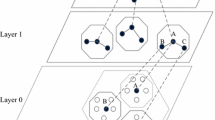Abstract
Periodical extraction of raw sensor readings is one of the most representative and comprehensive applications in Wireless sensor networks. In order to reduce the data redundancy and the communication load, in-network data aggregation is usually applied to merge the packets during the routing process. Aggregation protocols with deterministic routing pre-construct the stationary structure to perform data aggregation. However, the overhead of construction and maintenance always outweighs the benefits of data aggregation under dynamic scenarios. This paper proposes an Adaptive Data Aggregation protocol with Probabilistic Routing for the periodical data collection events. The main idea is to encourage the nodes to use an optimal routing structure for data aggregation with certain probability. The optimal routing structure is defined as a Multi-Objective Steiner Tree, which can be explored and exploited by the routing scheme based on the Ant Colony Optimization and Genetic Algorithm hybrid approach. The probabilistic routing decision ensures the adaptability for some topology transformations. Moreover, by using the prediction model based on the sliding window for future arriving packets, the adaptive timing policy can reduce the transmission delay and can enhance the aggregation probability. Therefore, the packet transmission converges from both spatial and temporal aspects for the data aggregation. Finally, the theoretical analysis and the simulation results validate the feasibility and the high efficiency of the novel protocol when compared with other existing approaches.





Similar content being viewed by others
References
Li, M., Li, Z., & Vasilakos, A. V. (2013). A survey on topology control in wireless sensor networks: Taxonomy, comparative study, and open issues. Proceedings of the IEEE, 101(12), 2538–2557.
Fasolo, E., Rossi, M., Widmer, J., & Zorzi, M. (2007). In-network aggregation techniques for wireless sensor networks: A survey. IEEE Wireless Communications, 14(2), 70–87.
Xiang, L., Luo, J., & Vasilakos, A. (2011). Compressed data aggregation for energy efficient wireless sensor networks. In IEEE communications society conference on sensor, mesh and Ad hoc communications and networks (SECON) (pp. 46–54).
Laukik, C., Alin, D., & Sanjay, R. (2008). Aggregation methods for large-scale sensor networks. ACM Transactions on Sensor Networks (TOSN), 4(2), 1–29.
Wei, G., Ling, Y., Guo, B., Xiao, B., & Vasilakos, A. V. (2011). Prediction-based data aggregation in wireless sensor networks: Combining grey model and Kalman Filter. Computer Communications, 34(6), 793–802.
Xu, X., Ansari, R., Khokhar, A., & Vasilakos, A. V. (2015). Hierarchical data aggregation using compressive sensing (HDACS) in WSNs. ACM Transactions on Sensor Networks (TOSN), 11, 45.
Chilamkurti, N., Zeadally, S., Vasilakos, A., & Sharma, V. (2009). Cross-layer support for energy efficient routing in wireless sensor networks. Journal of Sensors, 2009, 1–9.
Dijun, L., Xiaojun, Z., Xiaobing, W., & Guihai, C. (2011). Maximizing lifetime for the shortest path aggregation tree in wireless sensor networks. In IEEE international conference on computer communications (INFOCOM) (1566–1574).
Chao, C.-M., & Hsiao, T.-Y. (2009). Design of structure-free and energy-balanced data aggregation in wireless sensor networks. In IEEE international conference on high performance computing and communications (HPCC) (222–229).
Lu, Y., Chen, J. P., Comsa, I. S., Kuonen, P., & Hirsbrunner, B. (2014). Construction of data aggregation tree for multi-objectives in wireless sensor networks through jump particle swarm optimization. In International conference on knowledge-based and intelligent information & engineering systems (KES) (73–82).
Lee, M., & Wong, V. W. S. (2005). An energy-aware spanning tree algorithm for data aggregation in wireless sensor networks. In IEEE pacific rim conference on communications, computers and signal processing (PACRIM) (300–303).
Malhotra, B., Nikolaidis, I., & Nascimento, M. (2010). Aggregation convergecast scheduling in wireless sensor networks. Springer Wireless Networks, 17(2), 319335.
Fan, K.-W., Liu, S., & Sinha, P. (2007). Structure-free data aggregation in sensor networks. IEEE Transactions on Mobile Computing, 6(8), 929–942.
Vass, D., & Vidacs, A., (2007). Distributed data agregation with geographical routing in wireless sensor Networks. IEEE international conference on pervasive services (68–71).
Bagaa, M., Challal, Y., Ksentini, A., Derhab, A., & Badache, N. (2014). Data aggregation scheduling algorithms in wireless sensor networks: Solutions and challenges. IEEE Communications Surveys & Tutorials, 16(3), 1339–1368.
Lu, Y., Comsa, I.S., Kuonen, P., & Hirsbrunner, B. (2015). Dynamic data aggregation protocol based on multiple objective tree in wireless sensor networks. In IEEE international conference on intelligent sensors, sensor networks and information processing (ISSNIP) (1–7).
Meng, T., Wu, F., Yang, Z., Chen, G., & Vasilakos, A. (2015). Spatial reusability-aware routing in multi-hop wireless networks. IEEE Transactions on Computers, 99, 1–1.
Song, Y., Liu, L., Ma, H., & Vasilakos, A. V. (2014). A biology-based algorithm to minimal exposure problem of wireless sensor networks. IEEE Transactions on Network and Service Management, 11(3), 417–430.
Yao, Y., Cao, Q., & Vasilakos, A. V. (2015). EDAL: An energy-efficient, delay-aware, and lifetime-balancing data collection protocol for heterogeneous wireless sensor networks. IEEE/ACM Transactions on Networking, 23(3), 810–823.
Solis, I., & Obraczka, K. (2004). The impact of timing in data aggregation for sensor networks. In IEEE international conference on communications (ICC) (3640–3645).
Solis, I., & Obraczka, K. (2006). In-network aggregation trade-offs for data collection in wireless sensor networks. International Journal of Sensor Networks, 1(3), 200–212.
Ding, S. & Ishii, N. (2000). An online genetic algorithm for dynamic Steiner tree problem. In 26th annual conference of the IEEE industrial electronics society (IECON) (812–817).
Author information
Authors and Affiliations
Corresponding author
Rights and permissions
About this article
Cite this article
Lu, Y., Comsa, IS., Kuonen, P. et al. Adaptive data aggregation with probabilistic routing in wireless sensor networks. Wireless Netw 22, 2485–2499 (2016). https://doi.org/10.1007/s11276-015-1108-8
Published:
Issue Date:
DOI: https://doi.org/10.1007/s11276-015-1108-8




